2012 Hyundai Sonata ESP
[x] Cancel search: ESPPage 279 of 363
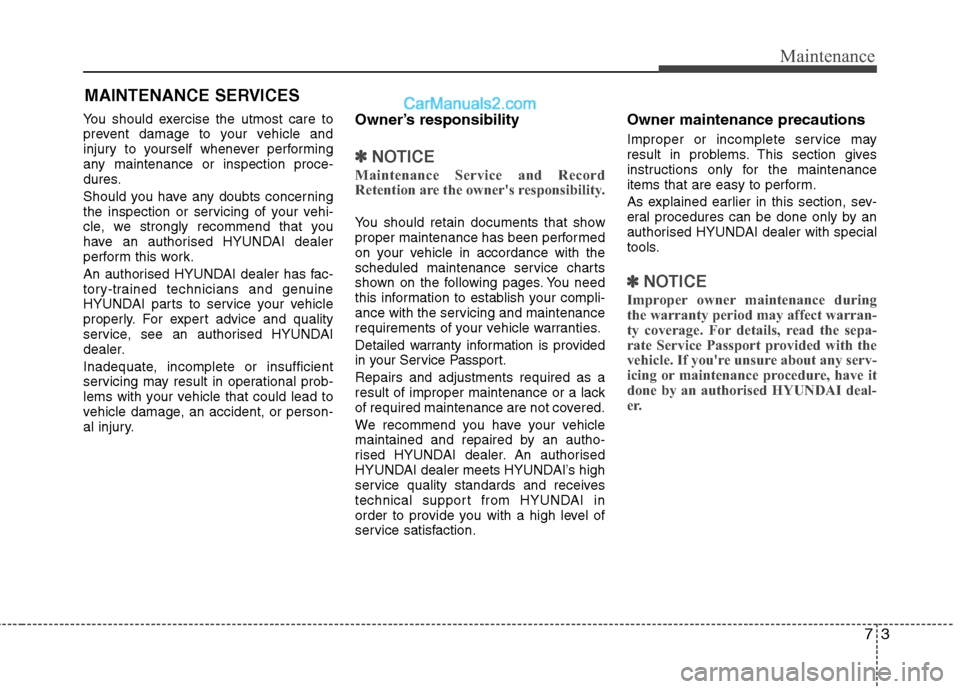
73
Maintenance
MAINTENANCE SERVICES
You should exercise the utmost care to
prevent damage to your vehicle and
injury to yourself whenever performing
any maintenance or inspection proce-
dures.
Should you have any doubts concerning
the inspection or servicing of your vehi-
cle, we strongly recommend that you
have an authorised HYUNDAI dealer
perform this work.
An authorised HYUNDAI dealer has fac-
tory-trained technicians and genuine
HYUNDAI parts to service your vehicle
properly. For expert advice and quality
service, see an authorised HYUNDAI
dealer.
Inadequate, incomplete or insufficient
servicing may result in operational prob-
lems with your vehicle that could lead to
vehicle damage, an accident, or person-
al injury. Owner’s responsibility
✽✽
NOTICE
Maintenance Service and Record
Retention are the owner's responsibility.
You should retain documents that show
proper maintenance has been performed
on your vehicle in accordance with the
scheduled maintenance service charts
shown on the following pages. You need
this information to establish your compli-
ance with the servicing and maintenance
requirements of your vehicle warranties.
Detailed warranty information is provided
in your Service Passport. Repairs and adjustments required as a
result of improper maintenance or a lack
of required maintenance are not covered.
We recommend you have your vehicle
maintained and repaired by an autho-
rised HYUNDAI dealer. An authorised
HYUNDAI dealer meets HYUNDAI’s high
service quality standards and receives
technical support from HYUNDAI in
order to provide you with a high level of
service satisfaction. Owner maintenance precautions
Improper or incomplete service may
result in problems. This section gives
instructions only for the maintenance
items that are easy to perform.
As explained earlier in this section, sev-
eral procedures can be done only by an
authorised HYUNDAI dealer with special
tools.
✽✽
NOTICE
Improper owner maintenance during
the warranty period may affect warran-
ty coverage. For details, read the sepa-
rate Service Passport provided with the
vehicle. If you're unsure about any serv-
icing or maintenance procedure, have it
done by an authorised HYUNDAI deal-
er.
Page 280 of 363
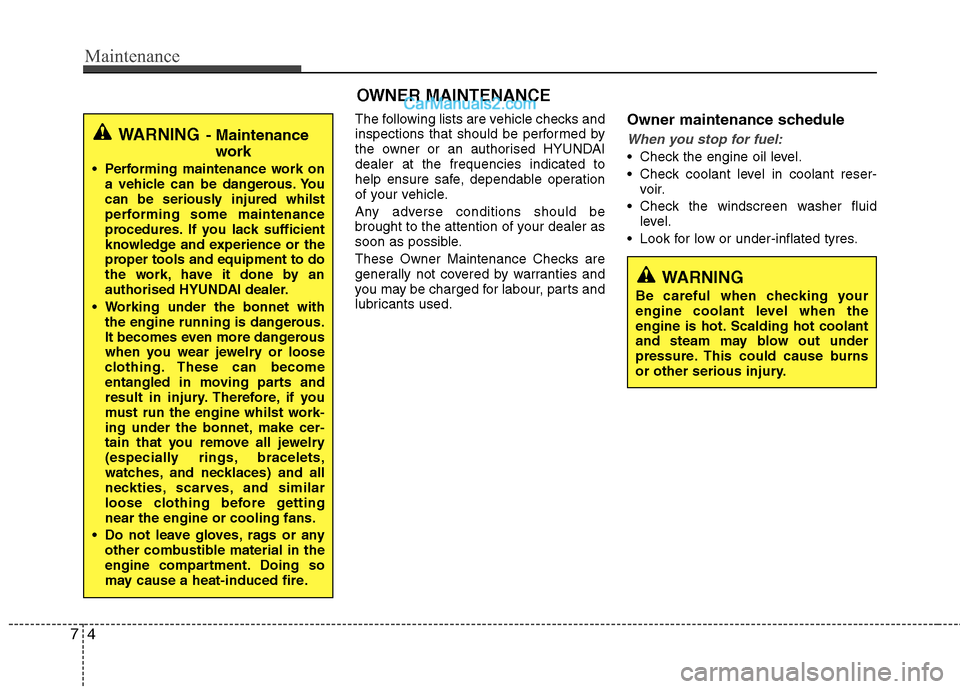
Maintenance
4
7
OWNER MAINTENANCE
The following lists are vehicle checks and
inspections that should be performed by
the owner or an authorised HYUNDAIdealer at the frequencies indicated to
help ensure safe, dependable operation
of your vehicle.
Any adverse conditions should be
brought to the attention of your dealer as
soon as possible.
These Owner Maintenance Checks are
generally not covered by warranties and
you may be charged for labour, parts and
lubricants used. Owner maintenance schedule
When you stop for fuel:
Check the engine oil level.
Check coolant level in coolant reser-
voir.
Check the windscreen washer fluid level.
Look for low or under-inflated tyres.
WARNING - Maintenance
work
Performing maintenance work on a vehicle can be dangerous. You
can be seriously injured whilst
performing some maintenance
procedures. If you lack sufficient
knowledge and experience or the
proper tools and equipment to do
the work, have it done by an
authorised HYUNDAI dealer.
Working under the bonnet with the engine running is dangerous.
It becomes even more dangerous
when you wear jewelry or loose
clothing. These can become
entangled in moving parts and
result in injury. Therefore, if you
must run the engine whilst work-
ing under the bonnet, make cer-
tain that you remove all jewelry
(especially rings, bracelets,
watches, and necklaces) and all
neckties, scarves, and similar
loose clothing before gettingnear the engine or cooling fans.
Do not leave gloves, rags or any other combustible material in the
engine compartment. Doing so
may cause a heat-induced fire.
WARNING
Be careful when checking your
engine coolant level when the
engine is hot. Scalding hot coolant
and steam may blow out under
pressure. This could cause burns
or other serious injury.
Page 314 of 363
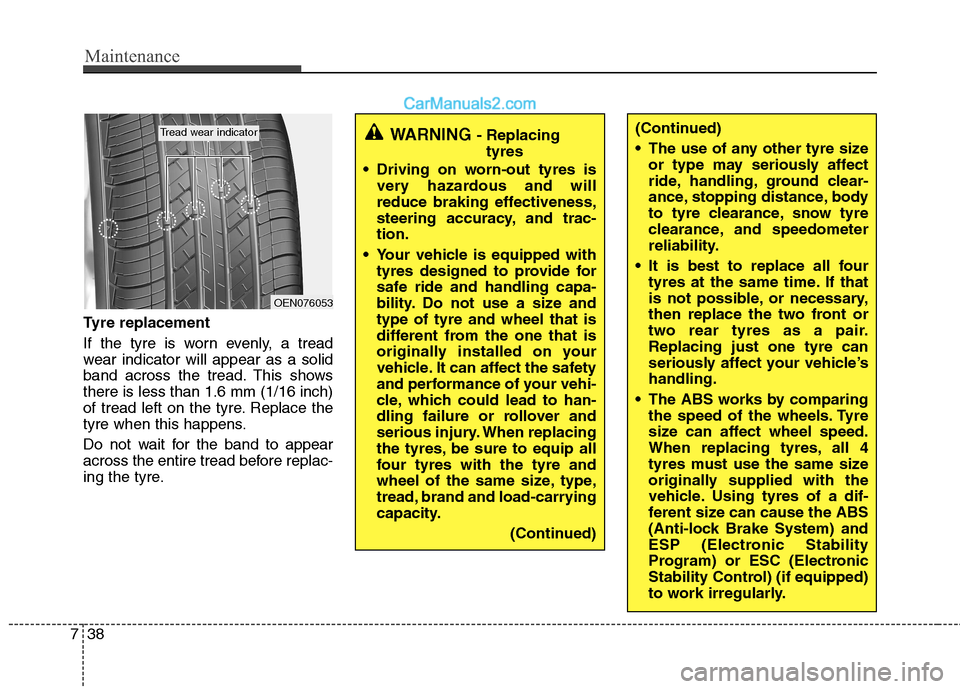
Maintenance
38
7
Tyre replacement
If the tyre is worn evenly, a tread
wear indicator will appear as a solid
band across the tread. This showsthere is less than 1.6 mm (1/16 inch)
of tread left on the tyre. Replace the
tyre when this happens.
Do not wait for the band to appear
across the entire tread before replac-
ing the tyre.
OEN076053
Tread wear indicator(Continued)
The use of any other tyre size
or type may seriously affect
ride, handling, ground clear-
ance, stopping distance, body
to tyre clearance, snow tyre
clearance, and speedometer
reliability.
It is best to replace all four tyres at the same time. If that
is not possible, or necessary,
then replace the two front or
two rear tyres as a pair.Replacing just one tyre can
seriously affect your vehicle’shandling.
The ABS works by comparing the speed of the wheels. Tyre
size can affect wheel speed.
When replacing tyres, all 4
tyres must use the same size
originally supplied with the
vehicle. Using tyres of a dif-
ferent size can cause the ABS
(Anti-lock Brake System) and
ESP (Electronic Stability
Program) or ESC (Electronic
Stability Control) (if equipped)
to work irregularly.WARNING - Replacing
tyres
Driving on worn-out tyres is very hazardous and will
reduce braking effectiveness,
steering accuracy, and trac-tion.
Your vehicle is equipped with tyres designed to provide for
safe ride and handling capa-
bility. Do not use a size andtype of tyre and wheel that is
different from the one that is
originally installed on your
vehicle. It can affect the safety
and performance of your vehi-
cle, which could lead to han-
dling failure or rollover and
serious injury. When replacing
the tyres, be sure to equip all
four tyres with the tyre and
wheel of the same size, type,
tread, brand and load-carrying
capacity.
(Continued)
Page 317 of 363
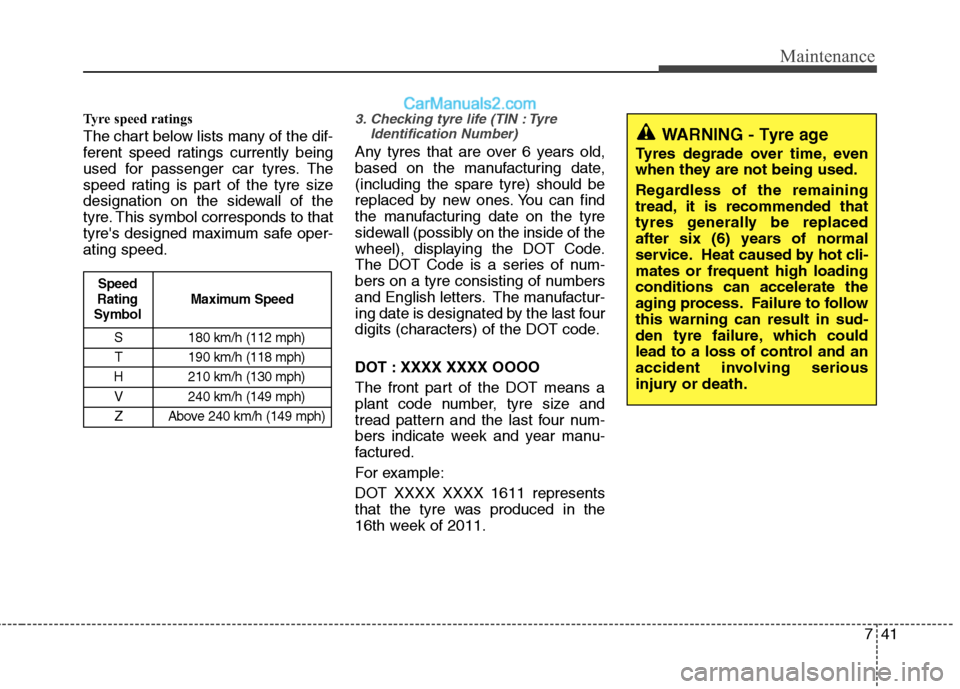
741
Maintenance
Tyre speed ratings
The chart below lists many of the dif-
ferent speed ratings currently being
used for passenger car tyres. The
speed rating is part of the tyre size
designation on the sidewall of the
tyre. This symbol corresponds to that
tyre's designed maximum safe oper-ating speed.3. Checking tyre life (TIN : TyreIdentification Number)
Any tyres that are over 6 years old,
based on the manufacturing date,(including the spare tyre) should be
replaced by new ones. You can find
the manufacturing date on the tyre
sidewall (possibly on the inside of the
wheel), displaying the DOT Code.
The DOT Code is a series of num-
bers on a tyre consisting of numbers
and English letters. The manufactur-
ing date is designated by the last four
digits (characters) of the DOT code.
DOT : XXXX XXXX OOOO
The front part of the DOT means a
plant code number, tyre size and
tread pattern and the last four num-
bers indicate week and year manu-
factured.
For example:
DOT XXXX XXXX 1611 represents
that the tyre was produced in the
16th week of 2011.
S 180 km/h (112 mph)
T 190 km/h (118 mph)
H 210 km/h (130 mph) V 240 km/h (149 mph)
Z Above 240 km/h (149 mph)
Maximum Speed
Speed
Rating
Symbol
WARNING - Tyre age
Tyres degrade over time, even
when they are not being used.
Regardless of the remaining
tread, it is recommended that
tyres generally be replaced
after six (6) years of normal
service. Heat caused by hot cli-mates or frequent high loadingconditions can accelerate the
aging process. Failure to followthis warning can result in sud-
den tyre failure, which could
lead to a loss of control and an
accident involving serious
injury or death.
Page 318 of 363
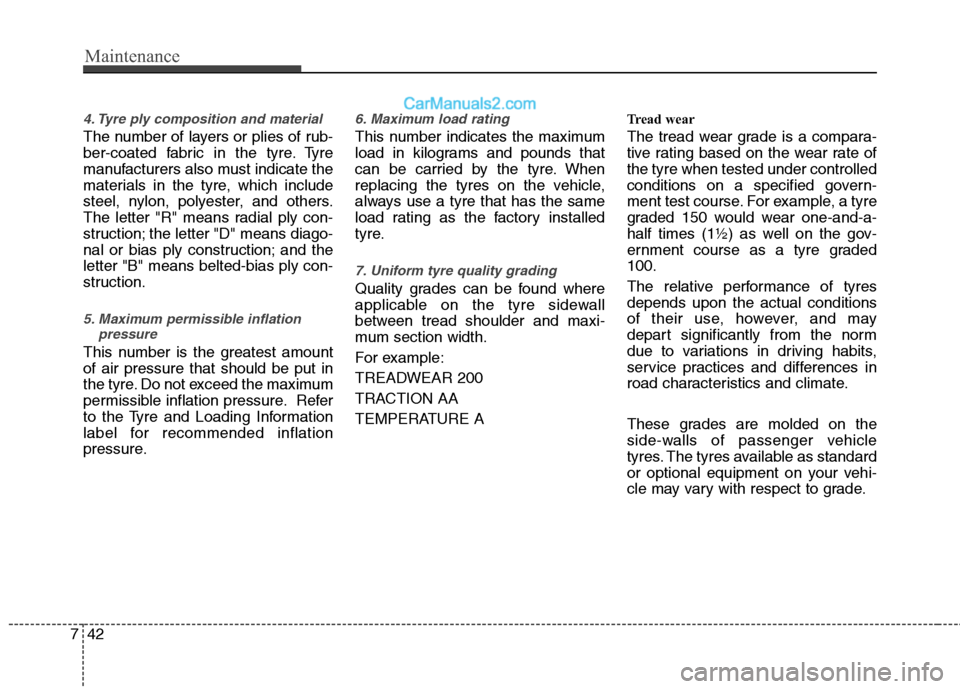
Maintenance
42
7
4. Tyre ply composition and material
The number of layers or plies of rub-
ber-coated fabric in the tyre. Tyre
manufacturers also must indicate the
materials in the tyre, which include
steel, nylon, polyester, and others.
The letter "R" means radial ply con-
struction; the letter "D" means diago-
nal or bias ply construction; and theletter "B" means belted-bias ply con-
struction.
5. Maximum permissible inflation
pressure
This number is the greatest amount of air pressure that should be put in
the tyre. Do not exceed the maximum
permissible inflation pressure. Refer
to the Tyre and Loading Information
label for recommended inflation
pressure.
6. Maximum load rating
This number indicates the maximum
load in kilograms and pounds that
can be carried by the tyre. When
replacing the tyres on the vehicle,
always use a tyre that has the same
load rating as the factory installed
tyre.
7. Uniform tyre quality grading
Quality grades can be found where
applicable on the tyre sidewall
between tread shoulder and maxi-
mum section width.
For example:
TREADWEAR 200
TRACTION AA
TEMPERATURE A Tread wear
The tread wear grade is a compara-
tive rating based on the wear rate ofthe tyre when tested under controlled
conditions on a specified govern-
ment test course. For example, a tyre
graded 150 would wear one-and-a-
half times (1½) as well on the gov-
ernment course as a tyre graded100.
The relative performance of tyres depends upon the actual conditions
of their use, however, and may
depart significantly from the norm
due to variations in driving habits,
service practices and differences in
road characteristics and climate.
These grades are molded on the
side-walls of passenger vehicle
tyres. The tyres available as standard
or optional equipment on your vehi-
cle may vary with respect to grade.
Page 327 of 363
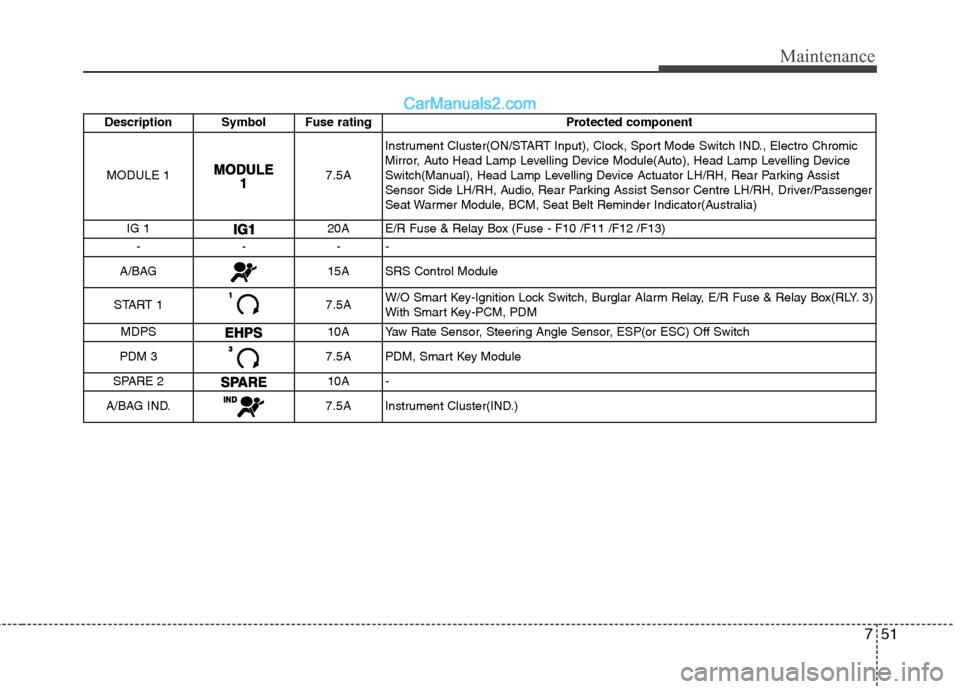
751
Maintenance
Description Symbol Fuse rating Protected componentMODULE 1
7.5A Instrument Cluster(ON/START Input), Clock, Sport Mode Switch IND., Electro Chromic
Mirror, Auto Head Lamp Levelling Device Module(Auto), Head Lamp Levelling Device
Switch(Manual), Head Lamp Levelling Device Actuator LH/RH, Rear Parking Assist
Sensor Side LH/RH, Audio, Rear Parking Assist Sensor Centre LH/RH, Driver/Passenger
Seat Warmer Module, BCM, Seat Belt Reminder Indicator(Australia)
IG 1
20A E/R Fuse & Relay Box (Fuse - F10 /F11 /F12 /F13)
--- -
A/BAG
15A SRS Control Module
START 1
7.5A W/O Smart Key-Ignition Lock Switch, Burglar Alarm Relay, E/R Fuse & Relay Box(RLY. 3)
With Smart Key-PCM, PDM
MDPS
10A Yaw Rate Sensor, Steering Angle Sensor, ESP(or ESC) Off Switch
PDM 3
7.5A PDM, Smart Key Module
SPARE 2
10A -
A/BAG IND.
7.5A Instrument Cluster(IND.)
Page 328 of 363
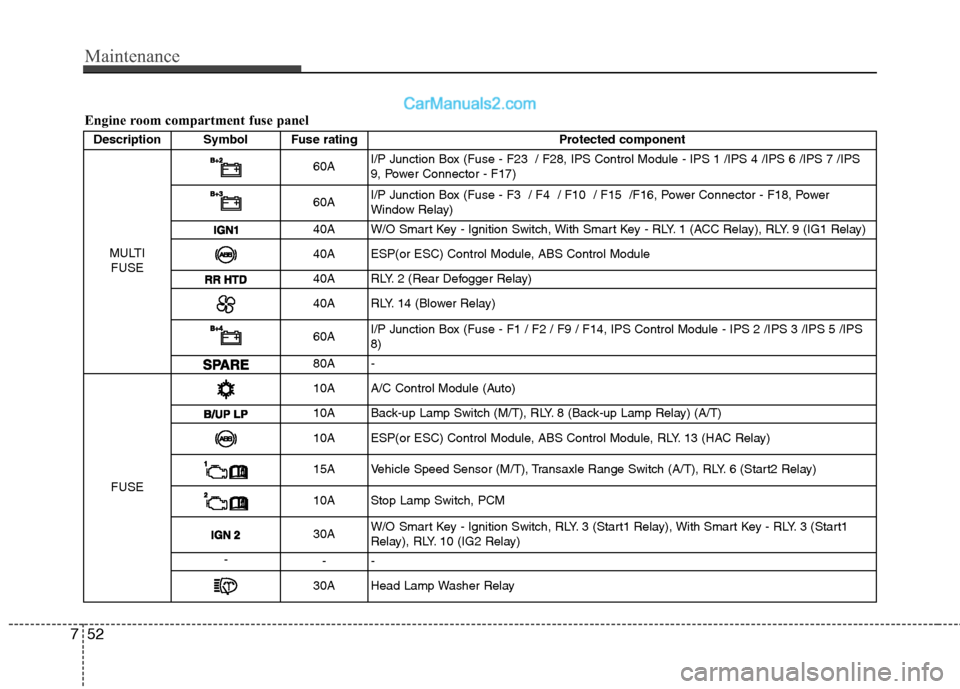
Maintenance
52
7
Description Symbol Fuse rating Protected component
MULTI FUSE
60A I/P Junction Box (Fuse - F23 / F28, IPS Control Module - IPS 1 /IPS 4 /IPS 6 /IPS 7 /IPS
9, Power Connector - F17)
60AI/P Junction Box (Fuse - F3 / F4 / F10 / F15 /F16, Power Connector - F18, Power
Window Relay)
40A W/O Smart Key - Ignition Switch, With Smart Key - RLY. 1 (ACC Relay), RLY. 9 (IG1 Relay)
40A ESP(or ESC) Control Module, ABS Control Module
40A RLY. 2 (Rear Defogger Relay)
40A RLY. 14 (Blower Relay)
60AI/P Junction Box (Fuse - F1 / F2 / F9 / F14, IPS Control Module - IPS 2 /IPS 3 /IPS 5 /IPS 8)
80A -
FUSE
10A A/C Control Module (Auto)
10A Back-up Lamp Switch (M/T), RLY. 8 (Back-up Lamp Relay) (A/T)
10A ESP(or ESC) Control Module, ABS Control Module, RLY. 13 (HAC Relay)
15A Vehicle Speed Sensor (M/T), Transaxle Range Switch (A/T), RLY. 6 (Start2 Relay)
10A Stop Lamp Switch, PCM
30A W/O Smart Key - Ignition Switch, RLY. 3 (Start1 Relay), With Smart Key - RLY. 3 (Start1
Relay), RLY. 10 (IG2 Relay)
- --
30A Head Lamp Washer Relay
Engine room compartment fuse panel
Page 329 of 363
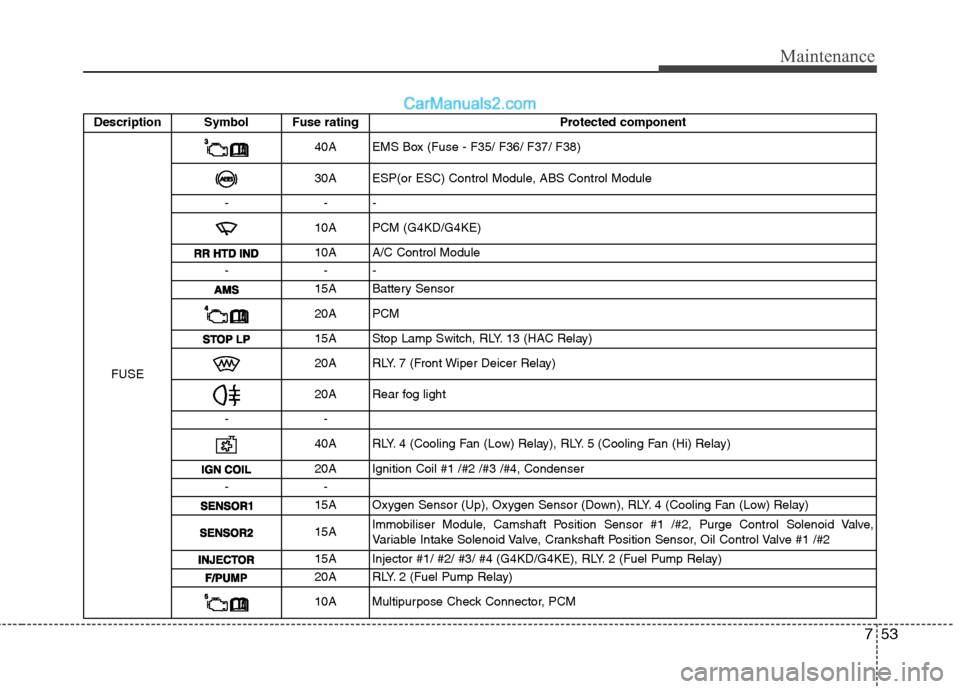
753
Maintenance
Description Symbol Fuse ratingProtected component
FUSE
40AEMS Box (Fuse - F35/ F36/ F37/ F38)
30A ESP(or ESC) Control Module, ABS Control Module
-- -
10A PCM (G4KD/G4KE)
10A A/C Control Module
-- -
15A Battery Sensor
20A PCM
15A Stop Lamp Switch, RLY. 13 (HAC Relay)
20A RLY. 7 (Front Wiper Deicer Relay)
20A Rear fog light
--
40A RLY. 4 (Cooling Fan (Low) Relay), RLY. 5 (Cooling Fan (Hi) Relay)
20A Ignition Coil #1 /#2 /#3 /#4, Condenser
--
15A Oxygen Sensor (Up), Oxygen Sensor (Down), RLY. 4 (Cooling Fan (Low) Relay)
15A Immobiliser Module, Camshaft Position Sensor #1 /#2, Purge Control Solenoid Valve,
Variable Intake Solenoid Valve, Crankshaft Position Sensor, Oil Control Valve #1 /#2
15A Injector #1/ #2/ #3/ #4 (G4KD/G4KE), RLY. 2 (Fuel Pump Relay)
20A RLY. 2 (Fuel Pump Relay)
10A Multipurpose Check Connector, PCM